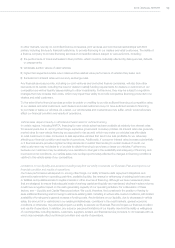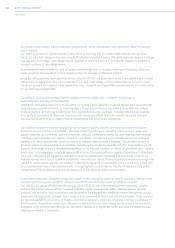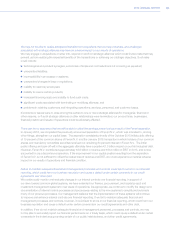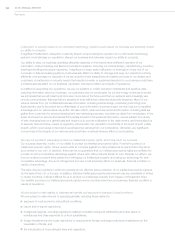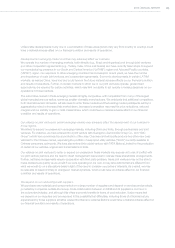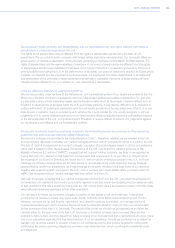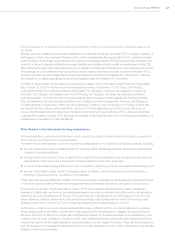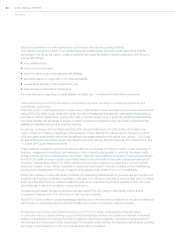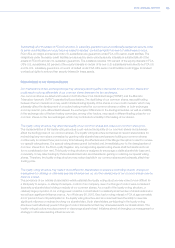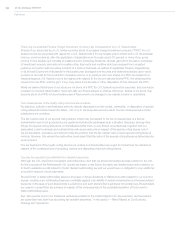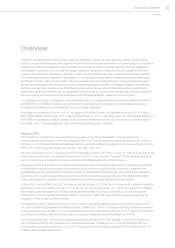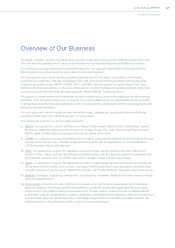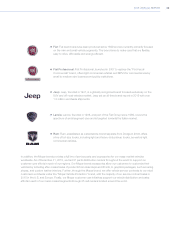Chrysler 2015 Annual Report Download - page 29
Download and view the complete annual report
Please find page 29 of the 2015 Chrysler annual report below. You can navigate through the pages in the report by either clicking on the pages listed below, or by using the keyword search tool below to find specific information within the annual report.
2015 | ANNUAL REPORT 29
Substantially all of the assets of FCA US and its U.S. subsidiary guarantors are unconditionally pledged as security under
its senior credit facilities and could become subject to lenders’ contractual rights if an event of default were to occur.
FCA US is an obligor and several of its U.S. subsidiaries are guarantors under FCA US’s senior credit facilities. The
obligations under the senior credit facilities are secured by senior priority security interests in substantially all of the
assets of FCA US and its U.S. subsidiary guarantors. The collateral includes 100 percent of the equity interests in FCA
US’s U.S. subsidiaries, 65 percent of the equity interests in certain of its non-U.S. subsidiaries held directly by FCA US
and its U.S. subsidiary guarantors. An event of default under FCA US’s senior credit facilities could trigger its lenders’
contractual rights to enforce their security interest in these assets.
Risks Related to our Common Shares
Our maintenance of two exchange listings may adversely affect liquidity in the market for our common shares and
could result in pricing differentials of our common shares between the two exchanges.
Our common shares are listed and traded on both the New York Stock Exchange (“NYSE”) and the Mercato
Telematico Azionario (“MTA”) operated by Borsa Italiana. The dual listing of our common shares may split trading
between the two markets and may result in limited trading liquidity of the shares in one or both markets, which may
adversely affect the development of an active trading market for our common shares on either or both exchanges
and may result in price differentials between the exchanges. Differences in the trading schedules, as well as volatility
in the exchange rate of the two trading currencies, among other factors, may result in different trading prices for our
common shares on the two exchanges, which may contribute to volatility in the trading of our shares.
The loyalty voting structure may affect the liquidity of our common shares and reduce our common share price.
The implementation of the loyalty voting structure could reduce the liquidity of our common shares and adversely
affect the trading prices of our common shares. The loyalty voting structure is intended to reward shareholders for
maintaining long-term share ownership by granting initial shareholders and persons holding our common shares
continuously for at least three years at any time following the effectiveness of the Merger the option to elect to receive
our special voting shares. Our special voting shares cannot be traded and, immediately prior to the deregistration of
common shares from the FCA Loyalty Register, any corresponding special voting shares shall be transferred to us
for no consideration (om niet). This loyalty voting structure is designed to encourage a stable shareholder base and,
conversely, it may deter trading by those shareholders who are interested in gaining or retaining our special voting
shares. Therefore, the loyalty voting structure may reduce liquidity in our common shares and adversely affect their
trading price.
The loyalty voting structure may make it more difficult for shareholders to acquire a controlling interest, change our
management or strategy or otherwise exercise influence over us, and the market price of our common shares may be
lower as a result.
The provisions of our articles of association which establish the loyalty voting structure may make it more difficult for
a third party to acquire, or attempt to acquire, control of our company, even if a change of control were considered
favorably by shareholders holding a majority of our common shares. As a result of the loyalty voting structure, a
relatively large proportion of our voting power could be concentrated in a relatively small number of shareholders who
would have significant influence over us. As of February 26, 2016, Exor had a voting interest in FCA of approximately
44.27 percent due to its participation in the loyalty voting structure and as a result will have the ability to exercise
significant influence on matters involving our shareholders. Such shareholders participating in the loyalty voting
structure could effectively prevent change of control transactions that may otherwise benefit our shareholders. The
loyalty voting structure may also prevent or discourage shareholders’ initiatives aimed at changing our management or
strategy or otherwise exerting influence over us.


